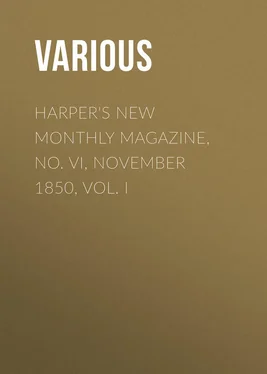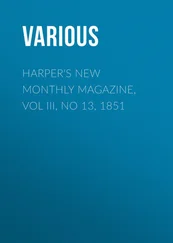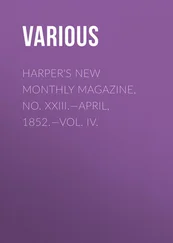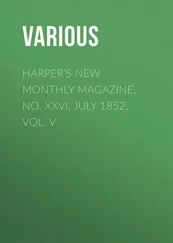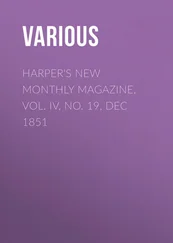Various - Harper's New Monthly Magazine, No. VI, November 1850, Vol. I
Здесь есть возможность читать онлайн «Various - Harper's New Monthly Magazine, No. VI, November 1850, Vol. I» — ознакомительный отрывок электронной книги совершенно бесплатно, а после прочтения отрывка купить полную версию. В некоторых случаях можно слушать аудио, скачать через торрент в формате fb2 и присутствует краткое содержание. Издательство: Иностранный паблик, Жанр: periodic, foreign_edu, на английском языке. Описание произведения, (предисловие) а так же отзывы посетителей доступны на портале библиотеки ЛибКат.
- Название:Harper's New Monthly Magazine, No. VI, November 1850, Vol. I
- Автор:
- Издательство:Иностранный паблик
- Жанр:
- Год:неизвестен
- ISBN:нет данных
- Рейтинг книги:5 / 5. Голосов: 1
-
Избранное:Добавить в избранное
- Отзывы:
-
Ваша оценка:
- 100
- 1
- 2
- 3
- 4
- 5
Harper's New Monthly Magazine, No. VI, November 1850, Vol. I: краткое содержание, описание и аннотация
Предлагаем к чтению аннотацию, описание, краткое содержание или предисловие (зависит от того, что написал сам автор книги «Harper's New Monthly Magazine, No. VI, November 1850, Vol. I»). Если вы не нашли необходимую информацию о книге — напишите в комментариях, мы постараемся отыскать её.
Harper's New Monthly Magazine, No. VI, November 1850, Vol. I — читать онлайн ознакомительный отрывок
Ниже представлен текст книги, разбитый по страницам. Система сохранения места последней прочитанной страницы, позволяет с удобством читать онлайн бесплатно книгу «Harper's New Monthly Magazine, No. VI, November 1850, Vol. I», без необходимости каждый раз заново искать на чём Вы остановились. Поставьте закладку, и сможете в любой момент перейти на страницу, на которой закончили чтение.
Интервал:
Закладка:
Vaughan urged in his defense, that his sole object was to deceive his affianced, and that he intended to destroy all the notes after his marriage. But it had been proved that the prisoner had asked one John Ballingar to change first one, and then twenty of the notes; but which that person was unable to do. Besides, had his sole object been to dazzle Miss Bliss with his fictitious wealth, he would, most probably, have intrusted more, if not all the notes, to her keeping.
He was found guilty, and passed the day that had been fixed for his wedding, as a condemned criminal.
On the 11th of May, 1758, Richard William Vaughan was executed at Tyburn. By his side, on the same gallows, there was another forger: William Boodgere, a military officer, who had forged a draught on an army agent named Calcroft, and expiated the offense with the first forger of Bank of England notes.
The gallows may seem hard measure to have meted out to Vaughan, when it is considered that none of his notes were negotiated, and no person suffered by his fraud. Not one of the forty-eight notes, except the twelve delivered to Miss Bliss, had been out of his possession; indeed, the imitation must have been very clumsily executed, and detection would have instantly followed any attempt to pass the counterfeits. There was no endeavor to copy the style of engraving on a real bank note. That was left to the engraver; and as each sheet passed through the press twice, the words added at the second printing, "For the Governor and Company of the Bank of England," could have fallen into their proper place on any one of the sheets, only by a miracle. But what would have made the forgery clear to even a superficial observer, was the singular omission, of the second "n" in the word England. 16
The criticism on Vaughan's note of a bank clerk examined on the trial was: "There is some resemblance, to be sure; but this note" (that upon which the prisoner was tried) "is numbered thirteen thousand eight hundred and forty, and we never reach so high a number." Besides there was no water-mark in the paper. The note of which a fac-simile appeared in our eighteenth number, and dated so early as 1699, has a regular design in the texture of the paper; showing that the water-mark is as old as the bank notes themselves.
Vaughan was greatly commiserated. But despite the unskillfulness of the forgery, and the insignificant consequences which followed it, the crime was considered of too dangerous a character not to be marked, from its very novelty, with exemplary punishment. Hanging created at that time no remorse in the public mind, and it was thought necessary to set up Vaughan as a warning to all future bank-note forgers. The crime was too dangerous not to be marked with the severest penalties. Forgery differs from other crimes not less in the magnitude of the spoil it may obtain, and of the injury it inflicts, than in the facilities attending its accomplishment. The common thief finds a limit to his depredations in the bulkiness of his booty, which is generally confined to such property as he can carry about his person; the swindler raises insuperable and defeating obstacles to his frauds if the amount he seeks to obtain is so considerable as to awaken close vigilance or inquiry. To carry their projects to any very profitable extent, these criminals are reduced to the hazardous necessity of acting in concert, and thus infinitely increasing the risks of detection. But the forger need have no accomplice; he is burdened with no bulky and suspicious property; he needs no receiver to assist his contrivances. The skill of his own individual right hand can command thousands; often with the certainty of not being detected, and oftener with such rapidity as to enable him to baffle the pursuit of justice.
It was a long time before Vaughan's rude attempt was improved upon: but in the same year (1758), another department of the crime was commenced with perfect success; namely, an ingenious alteration, for fraudulent purposes, of real bank notes. A few months after Vaughan's execution, one of the northern mails was stopped and robbed by a highwayman; several bank notes were comprised in the spoil, and the robber, setting up with these as a gentleman, went boldly to the Hatfield Post-office, ordered a chaise and four, rattled away down the road, and changed a note at every change of horses. The robbery was, of course, soon made known, and the numbers and dates of the stolen notes were advertised as having been stopped at the bank. To the genius of a highwayman this offered but a small obstacle, and the gentleman-thief changed all the figures "1" he could find into "4's." These notes passed currently enough; but, on reaching the bank, the alteration was detected, and the last holder was refused payment. As that person had given a valuable consideration for the note, he brought an action for the recovery of the amount; and at the trial it was ruled by the Lord Chief Justice, that "any person paying a valuable consideration for a bank note, payable to bearer, in a fair course of business, has an understood right to receive the money of the bank."
It took a quarter of a century to bring the art of forging bank notes to perfection. In 1779, this was nearly attained by an ingenious gentleman, named Mathison, a watchmaker from the matrimonial village of Gretna Green. Having learned the arts of engraving and of simulating signatures, he tried his hand at the notes of the Darlington Bank; but, with the confidence of skill, was not cautious in passing them, was suspected, and absconded to Edinburgh. Scorning to let his talent be wasted, he favored the Scottish public with many spurious Royal Bank of Scotland notes, and regularly forged his way by their aid to London. At the end of February he took handsome lodgings in the Strand, opposite Arundel-street. His industry was remarkable: for, by the 12th of March, he had planed and polished rough pieces of copper, engraved them, forged the water-mark, printed and negotiated several impressions. His plan was to travel and to purchase articles in shops. He bought a pair of shoe-buckles at Coventry with a forged note, which was eventually detected at the Bank of England. He had got so bold that he paid such frequent visits in Threadneedle-street, that the bank clerks became familiar with his person. He was continually changing notes of one, for another denomination. These were his originals, which he procured to make spurious copies of. One day seven thousand pounds came in from the Stamp Office. There was a dispute about one of the notes. Mathison, who was present, though at some distance, declared, oracularly, that the note was a good one. How could he know so well? A dawn of suspicion arose in the minds of the clerks; one trail led into another, and Mathison was finally apprehended. So well were his notes forged that, on the trial, an experienced bank clerk declared, he could not tell whether the note handed him to examine was forged or not. Mathison offered to reveal his secret of forging the water-mark, if mercy were shown to him; this was refused, and he suffered the penalty of his crime.
Mathison was a genius in his criminal way, but a greater than he appeared in 1786. In that year perfection seemed to have been reached. So considerable was the circulation of spurious paper-money, that it appeared as if some unknown power had set up a bank of its own. Notes were issued from it, and readily passed current, in hundreds and thousands. They were not to be distinguished from the genuine paper of Threadneedle-street. Indeed, when one was presented there, in due course, so complete were all its parts; so masterly the engraving; so correct the signatures; so skillful the water-mark, that it was promptly paid; and only discovered to be a forgery when it reached a particular department. From that period forged paper continued to be presented, especially at the time of lottery drawing. Consultations were held with the police. Plans were laid to help detection. Every effort was made to trace the forger. Clarke, the best detective of his day, went, like a sluth-hound, on the track; for in those days the expressive word "blood-money" was known. Up to a certain point there was little difficulty; but, beyond that, consummate art defied the ingenuity of the officer. In whatever way the notes came, the train of discovery always paused at the lottery-offices. Advertisements offering large rewards were circulated; but the unknown forger baffled detection.
Читать дальшеИнтервал:
Закладка:
Похожие книги на «Harper's New Monthly Magazine, No. VI, November 1850, Vol. I»
Представляем Вашему вниманию похожие книги на «Harper's New Monthly Magazine, No. VI, November 1850, Vol. I» списком для выбора. Мы отобрали схожую по названию и смыслу литературу в надежде предоставить читателям больше вариантов отыскать новые, интересные, ещё непрочитанные произведения.
Обсуждение, отзывы о книге «Harper's New Monthly Magazine, No. VI, November 1850, Vol. I» и просто собственные мнения читателей. Оставьте ваши комментарии, напишите, что Вы думаете о произведении, его смысле или главных героях. Укажите что конкретно понравилось, а что нет, и почему Вы так считаете.
